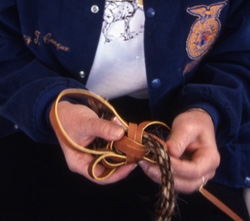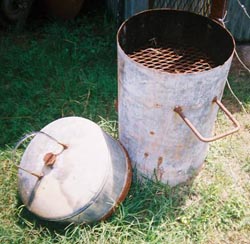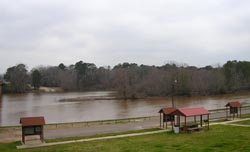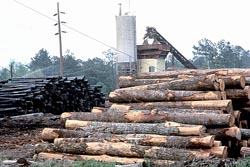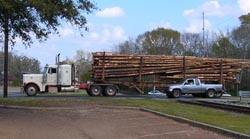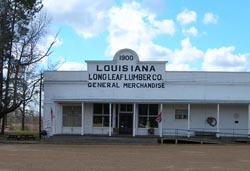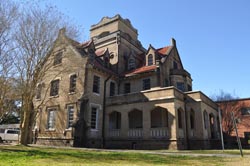Western Louisiana's Neutral Strip: Its History, People, And Legends
By Keagan LeJeune

Its Cultural Institutions
The Pioneer Church
Though in sharp contrast to the region's reputation for violence, the region's population is quite religious and God-fearing. Perhaps the most important social institution of the Neutral Strip is the pioneer church. Often a centralized small church linked several pioneering clans together into a community. Residents are quick to share with listeners the difficulties and hardships their ancestors overcame to settle in the region, and the importance of the church remains at the center of many stories. In the Neutral Strip, an important feature of a person's identity is their belonging to not only a certain Protestant denomination, but also to a specific church.
Churches provided pioneers and their communities with a foundation of faith and an important social organization that prompted fellowship and interdependence. Started by Methodists, Baptists, and many other denominations, several churches sprouted throughout the region during the second half of the 19th century, and nearly every early church in the region tells a story of a hard-working and disciplined preacher traveling by mule, by oxcart, or by foot to reach the faithful. Pragmatic and tough, these traveling preachers known as "circuit riders" were also scrupulous and righteous, withstanding hardships for the sake of their calling (Posey 1944).
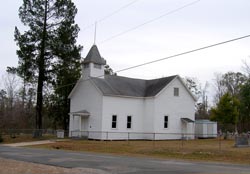
Attached to several churches in an area, a circuit rider would travel from one of his churches to another, eventually making a large circular route, or circuit, before returning home. When the circuit rider arrived, residents gathered for baptisms, weddings, funeral services, and revivals. Molded by frontier democracy, the preacher was well equipped to appeal to the typical member of his congregation. Usually the preacher combined farming with his church work, and early on, before churches were organized, the preacher received no pay for his services (Barton 2005). According to a common saying, the preacher worked as hard as any frontiersman: "For five or six days he toiled on the farm, and on the Sabbath he preached" (Posey 1944: 165). Local legend says one circuit rider arrived for each service he delivered with a Bible in his hand and a gun strapped to his saddle.
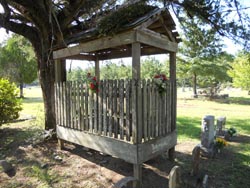
Marriages, too, were held when they could be had. Many people tell stories of a young couple arriving on a preacher's door on a Saturday or Sunday afternoon and asking to be married. In this circumstance, it was customary for the minister to receive a small payment. If an inexperienced groom asked the minister how much the service would cost, the wily preacher might ask in return, "How much is she worth to you?" (Nash 2013).
When available, preachers performed several rites. Baptisms were held in nearby creeks or rivers. Before a river baptism could take place, members of the congregation located a suitable site on the river—checking the water depth and clearing the riverbed of any danger. Finally, members constructed sheet tents for the candidates' dressing rooms.
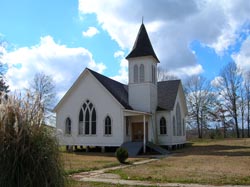
Revivals and camp meetings were also important social gatherings. Early church meetings often met outdoors and many of these meetings stretched over several days. Since many attendees traveled to make the meetings and tented overnight before returning home, these gatherings became known as "campground meetings" (Johnson 1955). Campground meetings functioned as important religious and social gatherings. At meetings, people would catch up on family news, visit with relatives they had not seen for weeks or months, trade goods, meet potential marriage partners, and reaffirm and reinvigorate their religious convictions.
Each day of a campground meeting consisted of three primary preaching services—morning, afternoon and night. These preaching services were led by an experienced evangelist. Often, other activities rounded out the day. Sometimes additional singing programs might precede the night service, or a "people's meeting" with prayer and testimony might precede the morning service. The focal point of almost all preaching services was the "altar call." At that point in the service, the faithful experiencing a call to holiness—a desire to be converted—would come forward and sit in the front benches. The preachers and other members of the faithful would pray and talk with those who came to the altar, urging them to "pray through to victory." On occasion, shouting and loud professions of faith and sanctification became part of the service.
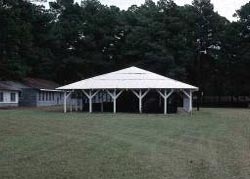
Most campgrounds adhered to a predictable layout and were arranged in an open horseshoe, oblong square, or circular pattern. Tents outlined the campground, and provisions for cooking, wagons, and livestock were stored behind the tents. At the end of the rectangle or at the center of the campground, people usually constructed an elevated preacher's stand. Separated by a wide center aisle, crude benches lined in rows faced the stand. Finally people built an altar, sometimes called a "mourner's bench," either by setting up a special section of benches or designating the front benches for that purpose.
Attendees also ate at the campground, and meals often became a communal event. Without the conveniences of today, participants sometimes went to great lengths to feed everyone. One man who attended campground meetings as a young boy recalled one evening when he and his father fed the group. He and his father drove a flock of turkeys down to the campground. The turkeys were cleaned and cooked, and all the gatherers were fed (Harper 1966).
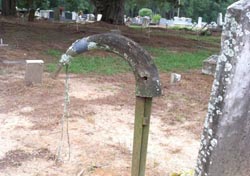
Stories of early circuit preachers still comprise a significant portion of the lore in the region. By far, the most legendary of all circuit riders is Joseph Willis. Willis preached in the Opelousas and Atakapa regions of Louisiana, and many claim that Willis was the first Baptist preacher to preach west of the Mississippi and that he established the first Baptist church west of the Mississippi (Willis 2002). Born in 1762 in the Carolinas, Joseph Willis made his way to southwest Mississippi by 1798 and by the early 1800s traveled to Louisiana. Father Willis, as he was affectionately known, established many Baptist churches in the region, including Occupy Baptist Church No.1 and Occupy Baptist Church No. 2. He often traveled great distances by foot to reach small groups. Many stories about Father Willis relate the sort of dangers he faced for his faith. Traveling preachers remain an active part of churches throughout the region, including traveling to a location to participate in revivals.
While there are very few stories about women being circuit riders, women were often responsible for the desire to establish churches and for maintaining them throughout the years. Women continue to play active roles in them, such as speaking at revivals, directing or participating in the musical portion of the service, teaching Sunday school, and leading Bible study. Like the women in their neighboring folk regions, women in the Neutral Strip also participate in a rich body of domestic crafts (Boykin 2012). Basket-making, especially by the American Indian populations in the Neutral Strip, and quilting are probably the most frequently practiced household crafts. Of course, foodways traditions are also maintained by women, and many of the foods, recipes and food practices necessitated by subsistence-living remain important to families even though packaged foods in grocery stores are now readily available. However, not all foods that are a part of the Neutral Strip's foodways tradition can be purchased at grocery stores or, at least, cannot be found at prices that allow most residents to enjoy them as frequently as they might like. Of these, deer and mayhaws seem to remain some of the most important foods. While some women do participate in deer hunts and are members of a deer lease and entire families participate in picking mayhaws, for the most part these two traditions seem to fall along gender lines.
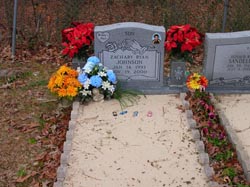
Deer acts as an important cultural food. Not only do hunting traditions and the social dynamics of hunting camps surround the food, but cottage industries for processing deer and the social act of sharing the food make deer a significant part of the region's folklore (Jones 1989, Wylie 1995). For example, deer sausage and especially backstrap, the cut of meat running the length of the spine and prized as a delicacy for its leanness, tenderness, and flavor, are often given as gifts or shared. While gathering and canning and preserving several different seasonal fruits, berries, and vegetables remain part of the region's foodways (Frantom 2012), mayhaws seem to occupy a special place in residents' idea of local foods. Mayhaws thrive in the sandy soil in the Neutral Strip, especially in low-lying areas like bottomlands along rivers and creeks or in baygalls—low-lying areas in pineflats that tend to retain water in the rainy season and whose sandy, moist soil gives rise to dense vegetation, including mayhaws. Collecting mayhaws and preparing them is a labor-intensive process, making the jelly all that more prized and all that more valuable as a gift.
Roads
Beyond the influx of people during the region's time as an official buffer, the Neutral Strip experienced two major periods of concentrated in-migration. First, Anglo-Americans migrated into the region after the Louisiana Purchase since it offered more open land than other portions of Louisiana. Second, the introduction of the railroad and the development of the timber industry drew a large number of new settlers into the region. The Anglo-Americans of the first wave faced a landscape sparsely populated since in the region "settlement was delayed by the political maneuvering and intrigue of European nations. . . . Legal settlement, including the establishment of legitimate government, religion, and the development of towns, roads, and industries was thwarted" (Smith 2003:42). As pioneers moving west and as people mingling with a transient population, residents of the Neutral Strip hold many stories about roads and moving along them.
Since the region held few established roads, key settlements quickly developed at the intersections of the handful of major roads or at ferries or fords used to cross one of the region's rivers and creeks (L'Herisson 1977; Smith 2003: 53-63). Near an ancient ford on Sugar Creek, Old Campground stands about halfway between one of the few ferries on the Sabine River and Alexandria, Louisiana, an important cattle market. Many early cattle drives through the area used Old Campground as a waypoint since it was located on one of the old cattle roads. Old Campground connects to various core components of the region's culture (e.g., religious convictions, settlement patterns, traditional occupations, etc), and an examination of it as a settlement can reveal a great deal about the region.
Certain archeological evidence and local lore suggest Native Americans used Old Campground as a camping site and eventually served as a trading post for these early people and the first French and Spanish people in the region. Locals also say people moving west camped there on their way further west. Several sources argue Old Campground Cemetery is the oldest documentable cemetery in southwestern Louisiana, but whether it's the oldest or not, its long-standing place in the region as a locus of settlement is clear. Early Methodist residents also used the expansive space as a place to hold religious meetings, which is how Old Campground earned its name (McFatter 1996).
The small community of Sugartown sits only a few miles west of Old Campground. First surveyed as a township in 1807, Sugartown was established in 1816 when the first white settlers began to arrive. It stands as the first permanent American settlement in southwest Louisiana. Residents pooled supplies and worked together to construct mills for making flour and sugar and gins for processing cotton. Like Sugartown, several early settlements in the region developed in this manner, and the culture of the region is defined by these small close-knit communities that developed at crossroads.
Cattle
One of the earliest white settlers near Old Campground and Sugartown area was "Saddler" Johnson. He was a skilled leather worker and a saddle maker and earned his nickname from the whips, boots, and saddles he made. Remnants of a tanning pit can still be seen there. While some of the region's early residents undoubtedly supplied cattle to the local population, the region also existed as a notable portion of early cattle drives. As early as the 1830s, Texan cattlemen drove surplus cattle from Stephen F. Austin's colony in east Texas across the Neutral Strip.
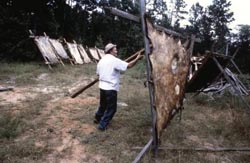
The Beef Trail, or Beef Road, ran from Texas to Alexandria and Natchitoches (Blake 2010). Branches of the road had several names. Cattle drovers and traders used the Beef Trail to move goods from the woods and prairies of Texas to larger markets, like Alexandria or Opelousas, where cattle could be sold and shipped to New Orleans, and from there, to any place in the world (Jones 2007: 17-18; Smith 2003: 63-64).
Along the route, several locations served, like old Campground did, as cattle "stands" since they provided access to pastures, fresh water, and a chance to resupply. Often these stands were located before waterways since for cattle drovers crossing a river or wide creek, known as "swimming the herd," proved to be their greatest and most dangerous challenge (Jones 2007: 148). Experienced cowboys also knew tricks to make the crossing easier. Many would never swim a herd across a waterway where the cattle would be facing the sun, for example, because cattle often spooked if they saw their reflections in the water. Simple ferries often set up shop at these locations and sold their services to the drovers.
Cattle ranching remains an important part of life in the region. Several of the region's historic traditional occupations (e.g., saddle makers and ranchers, etc.), crafts (e.g., leather goods and improvised handmade cookers and smokers) and foodways (e.g., brisket, cowboy stew, and chili) connect to the cattle industry and to the early interactions between Spanish Texas and Louisiana. However, ranching traditions have changed quite a bit in the region. For example, much of the work once done by horseback is now done by ATV. Moreover, ATVs are sometimes modified in order to fulfill the needs of the trade, so a rancher now often relies on the ingenuity of a welder rather than a saddle maker to make the cattleman's life easier. A great deal of the region's lore also relates to the industry. Many legends in the region, as well as place names, comment on the significance of early roads, like the Opelousas Trail, Nolan Trace, El Camino Real/the King's Highway, or the Old Confederate Road. These roads became infamous to locals, and a great deal of the stories in the Neutral Strip detail travelers falling prey to highwaymen and bandits. Even inns and boarding houses along the roads could be dangerous. Several legends circulate about treacherous innkeepers renting a room to a forlorn and exhausted traveler only to murder him in his sleep and steal his possessions. The best example of this is the Yokum Inn named after the infamous Yokum Gang, the Parkers' Halfway House, and the West and Kimbrell Gang who posed as law-abiding citizens but were actually a gang of robbers who waylaid boarders at the Kimbrell farm.
During the region's existence as an official buffer, rustling was bad enough that land owners petitioned both the Spanish and United States to send in troops to drive out the bandits (Haggard 1945:1059-1069). Even after the boundary dispute was settled, rustlers preyed on Louisiana stock since they could drive head stolen in Louisiana across the Sabine and essentially disappear. During the Civil War, jayhawkers often rustled cattle away from owners. Several early newspaper articles reported on the crime, especially after the rustlers were caught. In response to rustling, some communities formed vigilance committees. For instance, in 1884 a group called the "Regulators" organized in Cameron Parish to curb the lawlessness afflicting the cattle range (Block 1998). Stories about these vigilance committees, who sometimes seemed to be as brutal and menacing as the rustlers they were formed to capture, remain a part of the region's lore.
The Sabine River
As a boundary and as a thoroughfare of commerce and communication, the Sabine River acts as a major determiner of the region's culture. Along with key settlements at crossroads, a few of the region's earliest settlements existed at those few places along the Sabine that allowed for crossing—places with gentle slopes on each side and a crossable current.
First ferries were built at these crossings. Ferries varied in size and construction, but the familiar ferry in western Louisiana was a flat barge guided and propelled by a cable strung through a system of pulleys (Sharp 2012). Other businesses—like boarding houses or cattle stands—built up around these ferries, and eventually these sites developed into communities. In addition, a rich body of lore developed which surrounds these places.
Burr Ferry is one of the three or four early crossing points along the river. Burr Ferry's historical importance can be seen in its connection to the Nolan Trace (Martin 1966). This historic route earned its name because local legend says it follows the same route of adventurer and pathfinder Philip Nolan. Nolan blazed a trail from Louisiana to Texas, and Highway LA 8 that runs through Burr Ferry is known commonly as Nolan's Trace.
Many Texan cattlemen relied on Burr Ferry to cross the Sabine River in order to drive their herds to Opelousas and Alexandria, and many pioneers heading west used the ferry as a jumping off point to the Texas frontier (Martin 1967). Traders used the location to move goods across the Sabine, and the lore of the region also claims that outlaws quickly realized the ferry was a prime spot to ambush unsuspecting cattlemen and travelers. Trusting that only a reckless few would pursue them, outlaws often swam their horses across the river to escape. Sometimes, the treacherous waters proved too dangerous and legend says many were swept to their deaths, and the stolen gold left at the bottom of the Sabine.
Plunkaway Cemetery, a small cemetery near Burr Ferry, helps to perpetuate these stories. Plunkaway Cemetery contains many handmade concrete makers of "unknown'' graves that mark travelers who died along the trail. One legend says the cemetery acquired its unusual name from an outlaw who met his end sometime around 1850. The outlaw was injured in a shootout after a robbery and before he died, the locals asked the man where he wanted to be buried. "Just plunk me away over there," he said, and the name stuck (McManus 2008).
However, most of the lore surrounding Burr Ferry relates to Aaron Burr. Legend says the town was founded by Dr. Timothy Burr, a cousin of Aaron Burr. According to legend, Aaron Burr considered the crossing as an excellent staging point for his secret plan to invade Texas and annex it for the United States (Sharp 2012). This type of expedition—known as filibustering—was common in the Neutral Strip. On several different occasions, zealous adventurers financed, planned, and led filibustering expeditions across the Sabine in order to annex Texas as a part of the United States. While these attempts weren't successful, much of the region's lore, in addition to the Burr Ferry legends, connects to these plans. Some stories relate early settlers being the remnants of these groups, which is an attempt to account for the region's reputation as a place marked by a predilection for feelings of defiance and self-regulation, and other stories describe the buried treasures these groups hid before embarking on or upon returning from a campaign.
Before railroads replaced river traffic as the main method of shipping goods and moving people through western Louisiana, log rafts, flatboats, and keelboats teemed along the river (Block 1995). Great log rafts drifted down to sawmills in Orange. Small flatboats transported beef and other commodities, and keelboats on the Sabine moved cotton down to larger cities. Eventually, even sternwheelers and steamers populated the river. Steamers loaded with cotton made their way to Sabine Bay where cargo was loaded on larger ships for transport to New Orleans or Galveston. Trade on the Sabine gave rise to Logansport, Louisiana; Port Arthur, and Orange, Texas, and several other small river towns and landings. Nearly sixty landings existed between Logansport and Sabine Lake.
As a result, river life exists as an important part of the culture in the Neutral Strip. Churches not only used the river for baptisms, but revivals and camp meetings relied on the river for food and water. Attendees fished the river and large fish fries remain an important social activity and sometimes even as a fundraiser for a local church or club. Hunting along the Sabine remains an important social activity. Hunting clubs lease large swaths of forests and bottomland to hunt deer either by using deer stands or running dogs. The second method involves hunters positioning themselves at key locations along established game trails to ambush deer fleeing trained dogs released at one end of the woods. Once these dogs find the deer's scent, they begin chasing the deer, which drives the deer along the trails and by the hunters. A great many recreation activities also take place on the river. In warmer seasons, families swim in the river, even though its current can be dangerous and the sandy bottom often washes out at a moment's notice. Canoeing and boating on the river are also activities common in the area.
Perhaps the most significant change to the river was the establishment of Toledo Bend Reservoir in 1969, which spawned a thriving recreational fishing industry and the establishment of several camps along the reservoir.
Logging
By the 1870s and 1880s railroads began to replace steamboats as the most important medium for transporting trade goods (Stokes 1954). With railroads, logging operations no longer had to rely on waterways to transport logs. As a result, timber companies could cut tracts of trees far from rivers and stream. Railroads also meant that sawmills could ship finished lumber north to growing markets. Opening up great areas of previously unreachable timberland, railroads made it possible to build the large sawmills that would dominate the industry by the early 1900s. These large lumber mills brought with them an economic, legal, and social system that had a large impact on the region's culture (Stokes 1954).
The timber boom utterly changed the landscape of Louisiana's No Man's Land. Once a railroad ran through an area, investors scrambled to buy land and build a mill. Once a mill was built, workers flocked to the area to gain employment. From the 1890s to the 1920s timber towns quickly spread throughout Louisiana's Neutral Strip, and the region's population altered dramatically, not only increasing rapidly but bringing in new populations (McMahon 2004: 152-153).
Timber towns meant new workers. Swedes, Germans, African-Americans, Italians, Mexicans, and many, many more people came to cut trees in the woods or "to push" logs through the mills. Lumber companies brought with them surveyors, company managers, and bosses proficient in cutting timber and turning a profit (McMahon 2004: 153). Long-time settlers and entrenched families became neighbors with migrant mill workers and newly arrived mill foremen, often with set opinions and biases about entrenched local populations.
Two main hubs of activity comprised the timber industry—the logging camp and the sawmill. Each type of site influenced the culture of the region. An essential part of any extensive sawmill operation was the logging camp. Once a lumber company cut most of the tracts of trees near its mill, it established "front camps" deep in the woods to harvest timber and transport it by rail back to a mill in a nearby town (Stokes 1954). Some camps consisted of tents, some of boarding railcars, some of portable houses brought in by train and set on foundations, and some of shotgun houses quickly built. The camp became the hand of the lumber company, enabling it to expand very quickly and to bring in product at an incredible rate.
The logging camp needed to be deep in the woods to be close to the pine trees, so to a great degree, it existed in isolation. This fact meant that in several ways the logging camp existed by its own rules and standards. This was especially true of larger logging camps. A water pump kept the camp in water and generators gave it power. Camps held a post office, a store, and a doctor—all functioning in unison to harvest gum to make turpentine or to cut trees. The larger logging camps often constructed a church and a school, frequently one building functioning as both. The lumber company sometimes paid the cost of constructing these buildings since family men made better workers. Larger camps that operated for a considerable period of time often developed a sense of community and persisted after the trees were cut.
Many logging camps in the Neutral Strip first functioned as turpentine camps. Essentially, turpentine camps bled the pines of gum or pine resin that could be distilled into turpentine and rosin. The "turpentiners" came in a few years before the "fellers" came to cut down the trees. Established before the larger logging operations, turpentine camps occupied an area deep in the woods before the lumber company established a company town and sometimes even before the timber mill. Turpentine camps typically relied on workers still unskilled in the logging industry and often recruited former sharecroppers and immigrants (Outland 2004: 294). A portion of the Neutral Strip's African American population arrived as migrant workers following turpentine camps.
Beyond the logging camp, timber companies established sawmill towns, and many towns and cities in the Neutral Strip owe their existence to the sawmills built during the lumber boom. To ensure steady production and to increase profits, many timber companies developed company towns around their mills (Burns 1979:199-200). Company towns often included a doctor's office, company offices, a large commissary, a school, a church, and even a theater. The company town had many parts, but the commissary was its heart. Mill workers and their families bought all they needed at the company store. Commissaries drew not only local townspeople but also people traveling from some distance. Since the mill shipped its timber out on rails, the commissary had access to cargo shipped in by train, which meant it could stock a variety of items. The commissary also had the space to keep items on its shelves. As a result, the company commissary most often stood larger and better stocked than any store in nearby towns.
For many people in the Neutral Strip, a trip to the nearby commissary became part of their weekly ritual. Especially on Saturdays, folks traveled to the nearby store to buy a week's worth of groceries and to catch up on the news of the day. Over the years, commissaries began to serve as everything from a place for workers to collect their pay to a shopping center for the town, but perhaps their most important function was their social one. People visited while they milled around the store and gossiped while they stood outside its doors. Business deals, local meetings, Rotary Club functions, and even political speeches all happened on the platforms and streets adjacent to the commissary.
The commissary and other amenities in the timber town were meant to limit the timber workers' need to leave town and to improve their way of life. In addition, timber companies often sought to display the stability and progress the new industry would bring to the region. For this reason, several timber companies built large city halls or jails in cities, like in DeRidder and Oberlin, as proof that the timber companies meant more than an influx of rowdy workers and quickly erected logging camps and timber towns.
Along with former sharecroppers and hardened subsistence farmers, the steady pay of the sawmill often attracted drifters, confidence men, and speculators. The influx of a rough and rowdy workforce often caused tension with local farmers. Several stories in the region describe the fights and carousing that the transient workers engaged in, or people may tell stories about a specific outsider who arrived during the timber boom and developed a reputation for being particularly dangerous (LeJeune 2010). However, timber companies prided themselves on maintaining law and order in their company towns, but trouble often still found a way. As a result, one of the most active company employees was the "quarter-boss" (Stokes 1954). This man—some of the larger towns had several—was usually a peace officer deputized by parish authorities at the request of the company, which paid his salary. Whenever trouble hit town, the quarter-boss kept the peace. Several stories in the region relate a particularly effective or tough quarter-boss or sheriff who worked to bring order to a place. For instance, people describe how Quinton Brandon in Zwolle, Paul McMillian in Red Hill, or Julian Campbell in Old Hoy used their wile, grit, and skill to rein in rowdy timber workers.
The economic and social dominance of the timber industry had a profound effect on the region's culture. Not only do several key lumber towns remain as parish seats or hubs, but those timber towns turned to "ghosts" remain in the stories people tell (Martin 1966, 1967). The former glory of a town, the incredible output of a mill, the progress and amenities it offered are often related as part of the region's oral history. In addition, many closed mills and ghost towns have periodic reunions in which former workers and their families return to the site and share memories of their life before the mill closed. However, much like the lore found in the oil industry, an equal portion of the lore surrounding the timber industry in the region involves the tension between the encroaching sawmills and the entrenched residents. Unscrupulous timber surveyors and power-hungry timber owners become familiar characters in stories.
Military Culture in the Neutral Strip
The boom and prosperity of the timber and logging era had faded away by the 1930s. With the absence of logging and the economic impacts of the Great Depression, few employment opportunities existed in the small communities of No Man's Land. Many residents moved elsewhere to seek work. The migrating workforce left behind cut-over woods littered with stumps and a landscape absent of people. When the U.S. Army sought a suitable location to host massive pre-World War II military training exercises, these conditions made the place ideal. The Army knew these maneuvers needed a locale with rough terrain and harrowing conditions in order to simulate the settings of war. The Army hoped that Louisiana's unmarked roads, swamps, and changing elevations would challenge soldiers' adaptability under "real" conditions.
The Kisatchie Forest authorities allowed the Army to use 259,400 acres for the maneuvers, and the Army's Rent and Claims Board struck deals with locals who sold or rented their private land. Collectively, the Army had access to over 300,000 acres of land in Louisiana (Kane and Keeton. 2004). Held from 1940 to 1944, The Louisiana Maneuvers consisted of a series of war games each year, but two major war games, one in 1940 and one in 1941, are most remembered by locals. The exercises tested the effectiveness and adaptability of soldiers and weapons and determined which senior officers could command large infantry and armored divisions. General George Patton and General Ike Eisenhower participated in the early maneuvers and established their military prowess through the exercises.
Leesville played an important role in the maneuvers. In 1940 the U.S. Army built Camp Polk near the city. Millions of men and vehicles moved through Vernon Parish. Engineers repaired roads and reinforced bridges. Soldiers bought supplies, went on leave in nearby towns, and found girlfriends and wives. Camp Polk, which would become Fort Polk in 1962, forever changed the cultural landscape of Leesville.
Stories about the training exercises remain a significant portion of the lore in Vernon Parish. Many residents still remember watching from rooftops as tanks rolled through the streets of Leesville and fired blanks from their huge guns. Soldiers and tanks fired blanks, and airplanes dropped flour-sacks as bombs. To gauge losses from a fight, umpires developed a complex system of assessing damages, but almost always vehicles and structures covered in flour were considered completely destroyed. Locals joke that a farm wife could judge the damage of a bombing run by how many biscuits she could make from the flour covering the battlefield.
People also tell stories about the number of men who came into the area or by being mesmerized by the passing lines of troops—e.g., the rumble of a throng of passing tanks or the clop of hooves as an uninterrupted line of cavalry crossing a bridge lasted from dawn until dusk. Once the maneuvers began, soldiers slept in pastures, barns, and even on the porches of local residents. Locals remember stepping over rows and rows of the sleeping G.I.s. The residents also traded with the men or loaned them useful pieces of equipment, like wash basins or water buckets. Soldiers usually returned such gifts with their own—a basin filled with their only form of payment, C-rations and candy bars.
Relationships between citizens and the troops, though, were not always harmonious. Locals say that replicating the conditions of war, the soldiers tore down fences to open the way for convoys, seized woodpiles stashed on local farms, and foraged through cornfields and corncribs to find extra food for their cavalry mounts. A few residents hung signs that read, "Troops—KEEP OUT." One common story told is that a local farm wife refused the use of her land until the officer asked her, "Madam, don't you know that Louisiana is at war with Texas and don't you want Louisiana to win?" She replied, "I sure do. Give me that paper to sign."
One of the most legendary feats of the training exercises was pulled by General Patton. The second campaign of the 1941 maneuvers called for the Blue Army to attack Shreveport defended by Lt. Gen. Ben Lear and his anti-tank divisions of the Red Army. Through a daring flanking maneuver, Patton led a caravan of tanks nearly 300 miles to help Krueger's Blue Army take Shreveport. Patton also developed a reputation for being especially friendly to locals, especially store owners. Of all the officers to participate in the Louisiana Maneuvers, none has generated more stories than George Patton. Patton struck a famous deal with store owners when during a retreat he bought up all the gasoline along a route in order to stop the advancing opposing army. Patton also struck a legendary deal with another store owner in Many. They agreed that all soldiers under his command could buy goods on credit. One day two soldiers taking advantage of the agreement stood complaining to the store owner about Patton when he walked up unnoticed. He listened to them curse him for a moment, then slapped them on the back and told them to keep up the good work. He explained his actions to the store owner simply: "I like such fighting spirit in my men." He paid the division's $500 bill and left.



